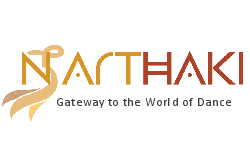
|   |

|   |
Centuries old Jaipur style of Kathak hosted in Maharashtra - Kiran Java e-mail: kiran@kiranjava.com March 16, 2025 The graceful Kathak maestro Pt Rajendra Gangani of the Jaipur gharana of Kathak was invited to conduct a workshop by Dr. Nandkishore Kapote, senior Kathak exponent of the Lucknow Gharana as part of the 45th anniversary year celebrations of Nandkishore Cultural Society in Pune. Since the early 90s, Nandkishore Cultural Society has had the privilege of hosting celebrated performers including Sitara Devi of the Banaras Gharana, Ramlal Bareth of the Raigarh Gharana, and Birju Maharaj of the Lucknow amongst other legends. This year, the workshop by the Delhi-based performer Rajendra Gangani, started the celebrations. Over 70 dancers from Pune, Pimpri-Chinchwad, and the Nigdi area participated in the workshops on 22 and 23 February 2025. Gangani is the leading exponent of the Jaipur style of Kathak and is known for his innovative style and technical wizardry. For the Junior batch, Gangani taught the traditional 'bhoomi pujan' of the Jaipur gharana in 16 beats, followed by the Tatkar - rhythmic footwork patterns at varying speeds set to specific taals. The Jaipur gharana is known for its intricate footwork and technical precision. Gangani gave the participants an insider tip on dancing the Tatkar at high speeds to develop their skill, stamina, and artistry. He instructed the participants to clasp their hands tightly while holding their torso strong. This ensured that the weight was distributed across the shoulders, allowing the feet to move freely and perform the tricky rhythmic patterns. Gangani was happy to see dancers who learned Kathak from different Gurus in Pune come together to attend the workshop. "Many flowers come together to form the bouquet of Kathak," he smiled. 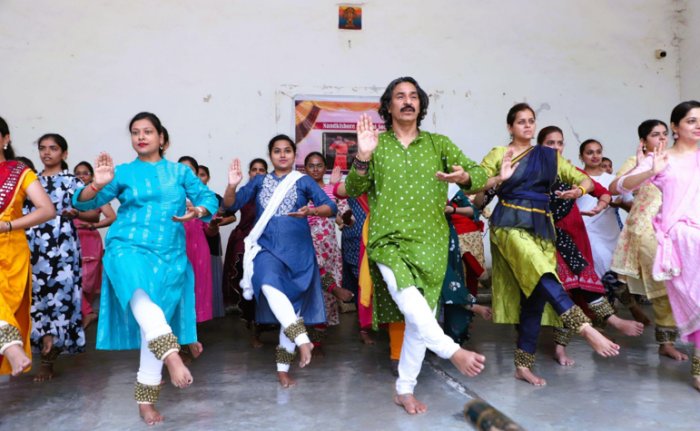 Photo credit: Narendra Ghodake He taught the participants a beautiful 'lamchand tihai' that could be used for their dance practice. This polyrhythmic piece was repeated three times at equal intervals as normal 'tihais' but in this case, it involved a longer and more complex set of phrases finishing on the first beat of the next cycle. The patterns were set so that there were equal taps by both the left and right feet and allowed the dancer to distribute the weight on both legs equally while engaging the floor with the feet. "Don't stomp the feet haphazardly, the feet should be placed with control," he advised. "You should be able to 'hear' the feet clearly. If you can hear it then the audience will hear it too," he declared. He asked the participants to shift their bodies to the right, left, and front and tilt their bodies to hear how slight shifts impacted the sounds made by the feet. "Experiment in your riyaz," he added. "The classical art is not a 5-minute capsule, it's a long sadhana to be relished." Gangani explained that the practice of 'Paltas' ('Baant' as they are called in other Kathak traditions), 'ladi', 'lamchand tihai', etc. are opportunities to keep the 'riyaaz' practice alive and keep one connected to Kathak dance. Suddenly he glimpsed a Ganesha statue in the hall and was inspired to teach the 'Ganesh Paran - "Jai Ganesh Gananath Daya Nidhi" to the participants. He threw a question at them asking the difference between a 'Paran' (rhythmic composition using the bols of the pakhawaj instrument) and a 'Kavitt' (poetic composition set to different taal, both traditional composition categories in Kathak.) He said both used pakhawaj bols in the Jaipur tradition and both narrated episodes or stories and both were set to rhythmic patterns. He shared that the difference lay in the content because 'Parans' spoke about the glories or importance of the deity whilst 'Kavitts' were 'shringarik' in nature and spoke of the 'leela' plays of the Lord. He asked the participants to focus on the movements and emphasized that 'Parans' were fast and the words changed rapidly. "One has to calculate movements carefully and cleverly like a supercomputer," he laughed and then explained that if the dancer did not pay attention there would be a lag in the rhythm. "Keep track of the smaller movements in between the larger movements, otherwise time will be lost." He gave an example of the style of benediction of various deities to show how the subject matter impacted the timing and rhythm. 'Ashiwaad' or Benediction of Shiva, Durga, etc. is shown with larger movements and benediction by Ram and Krishna are closer to the body. He emphasized the role of the eyes in the performance and asked the participants to practice using the eyes effectively as the audience will most certainly follow the movements. Having an experienced stage performer, performing on international stages brought a fresh perspective and different dimension to the workshop. Through a 'Kavitt', he taught and demonstrated to the senior students how to use stage space effectively. He shared that the Jaipur tradition had long 'Kavitts', and his forefathers had written some as lengthy as 'Dashavatara' compositions. He gave the example of the 'Kaliya Daman Kavitt'. He said, "Right now, you are learning, so it's all in your head and brain. But you need to internalize it in your heart - only then can you truly dance it." He emphasized that dance is not just about mudras or the movements of the hands and arms; the entire body must move in harmony, with the arms and feet working together to present a movement from the correct perspective. 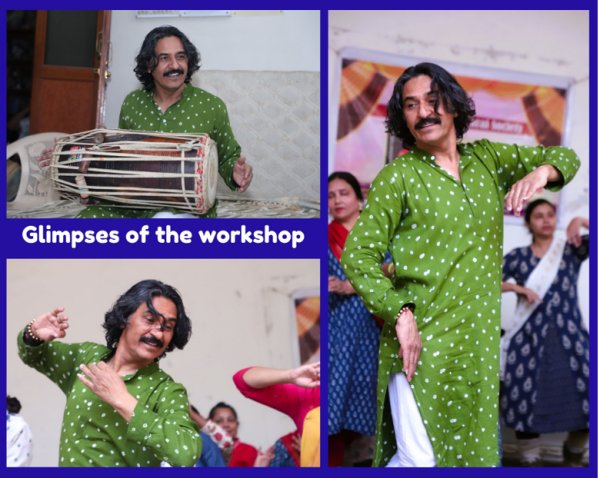 Photo credit: Narendra Ghodake To illustrate this, he demonstrated a fleeting Sundari Greeva between the motions of pulling out a flute and playing it. I asked, "Would the audience even notice that?" He smiled and replied, "Well, you saw it!" Then he added, "Perhaps not the ones in the back rows, but those in the front will certainly catch it. The audience sees more than we think they do." Whilst in Pune, Rajendra Gangani was also invited by Dr. Kapote, Director at The School of Liberal Arts, a constituent unit of Dr. D. Y. Patil Vidyapeeth (DPU) to conduct a lecture demonstration at their university. The dance department has been set up by educationist and philanthropist Dr. Bhagyashree Patil, Pro-Chancellor of Dr. D. Y. Patil Vidyapeeth who is a Bharatanatyam dancer herself and believes that the performing arts have to be nurtured and preserved. Gangani was welcomed by Prof. (Dr.) N. J. Pawar, Vice-Chancellor of Dr. D Y Patil University. 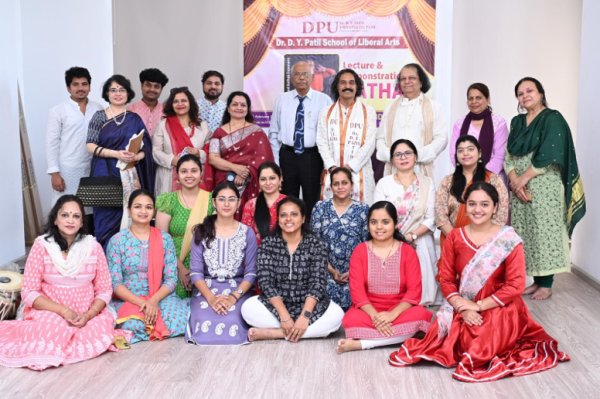 Photo credit: S. Pomaji Addressing the audience, Gangani said that he was happy that a formal performing arts school had been set up where arts could be nurtured like a flower. "The arts need to blossom with the teachings of the mentors and at the same time the students have to fulfill the requirements of pursuing a degree." He emphasized that just as our language, food, and other traditions have to be preserved, in the same way, it is our responsibility to come together to protect and preserve the performing arts of India. He shared insights from his journey in Kathak, how he followed the path of his father, and learned the traditional compositions from a young age as well as in an institutional setting. When he graduated, he was sent to Dehradun to teach for a while. He demonstrated the traditional Jaipur style of 'Govardhan Kavitt', 'Makhan Chori Kavitt', a 'Paran' showing a storm, and finished with a 'Gat' from the legendary Kathak dancer Narayan Prasad. 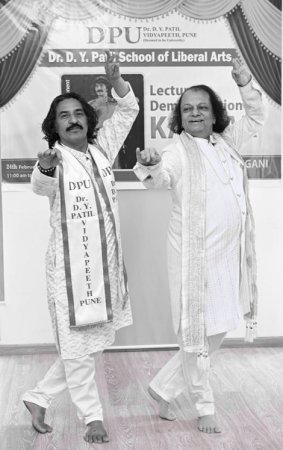 Pt Rajendra Gangani and Dr. Nandkishore Kapote Photo credit: S. Pomaji He emphasized that a play of rhythm impresses the audience. Looking at the accompanists he added that the accompanying musicians should also be learned and have a good understanding of laya. The musician accompanists for the workshops were Umesh Purohit on the harmonium and Santosh Salve on the tabla. Accompanists for the lecture demonstration were Yash Trisharan on the tabla, Akshay Pawar on the pakhawaj, and Haribhau Asatkar on the harmonium. 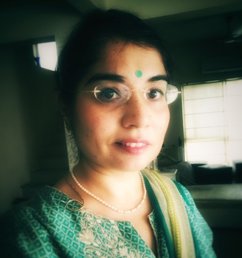 Kiran Java is a published author known for her books on sacred narratives and articles on classical dance. She has a M.A. in Mass Communication and Journalism, B.Sc. in Business Administration, Diploma in Natyashastra, and Certificate in Vallabh Vedant from Mumbai University. For more information visit kiranjava.com |